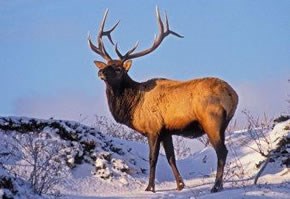It's early morning in the wilderness around Burwash and the
unmistakable, thundering bugle of a massive 1,000-pound bull
elk pierces through the fog.
The sound is music to the ears of the dedicated people
involved with the Sudbury Elk Restoration project because it's
the sound of success.
Initiated in 1993, the project has grown, slowly but surely,
since some 40 new elk were reintroduced to Burwash in 1998.
(More animals were released over the years as well.)
The project has completed Phase 1, which was to acquire a
local elk herd.
Now, it's in Phase 2, which is all about improving the
habitat for the rugged animals.
"We are looking at major causes of mortalities and working
to reduce those causes," said project scientist Ivan Filion.
"We've just created a new local committee to co-ordinate this
phase. It has given itself a 10-year timeline to carry out
those functions."
Improving the habitat means concentrating on food sources
for the elk.
"We conduct periodic, controlled burns in fields to get rid of
layers of dead grass that inhibits the growth of good forage,"
said Mike Hall, area biologist with the MNR. "We try to
maintain a grassland habitat."
Having the right food sources is vital to the elk's
survival.
"There's three critical food sources for elk," said Josef Hamr, director of Northern Environmental Heritage Institute at Cambrian College.
"There's grass, mast (acorns and nuts) and winter browse
(twigs, buds and fresh shoots of cedar and red maple trees).
Whatever can be done to stimulate these sources will improve
the habitat for elk."
The three sources help elk get through the harsh northern
winter climate, which can be deadly to animals in the
wilderness.
"If they have high quality grazing opportunities, it
prepares the elk for the tough winters," said Filion. "It gives
them insurance to get through the tough months of winter when
food is scarce. The better they feed in the summer, the better
their bodies are for the winter hardship."
Project leaders fly over the herds in early winter (late
December or early January) to count the number of calves
associated with cows for an update on the ratio. They then fly
over the herds again in late March and recount the calves/cows
ratio. It provides a scope of just how the herd is growing and
surviving.
"The ones that are still alive at the end of March are
unlikely to die before the next season...and are the annual
addition to the population," said Hamr. "The growth goes up and
down. We had some bad years in the beginning, but from 2003,
the numbers have increased steadily. Last year, 50 percent of
the cows had their calves at the end of winter."
In Burwash, the herd is estimated to be between 80 to 100 animals.
Around Killarney, estimates have been pegged at between 30
to 40 elk.
"In Sudbury, before we started, the herd was estimated to be
between 20 to 30 animals," said Filion. "There's no doubt the
elk is back."
Hamr says the ideal number for this area would be around
500.
Having a flourishing elk herd is part of the big picture of
re-greening and environmental rehabilitation.
"It just part of the reclamation project of Sudbury and
stimulates people's interest in the environment as a whole,"
said Nels Conroy, co-chair of the Elk Restoration Fundraising
Committee.
The elk's presence has really shown up on the MNR radar, as
they field calls all the time about sightings.
"We get sighting reports and they're always positive," said
Hall. "The people talk about how it's a real treat to see these
animals."
Because the elk is the most vocal of the deer family and
have such natural beauty, an eco-tourism market could be
forged.
"When you see elk, you see many at one time," said Filion.
"In the fall they're very vocal with their bugling. That's the
attributes that makes the animals so attractive to wildlife
enthusiasts...There's great potential."
Sudbury should feel honoured for being part of a successful
wildlife project of this magnitude.
"The people here should be proud of what's occurred," said Filion.
"It's been one of the most ambitious large mammal
restoration projects in the history of Ontario and it's been a
success."
The Sudbury Elk Restoration organization will hold its 10th
anniversary fundraiser gala at the Caruso Club on Thursday,
April 20. There are many prizes to be won and bid on, including
a coveted trip for a close encounter with a majestic bull elk.
More information about the project, go to www.sudburyelk.com .
